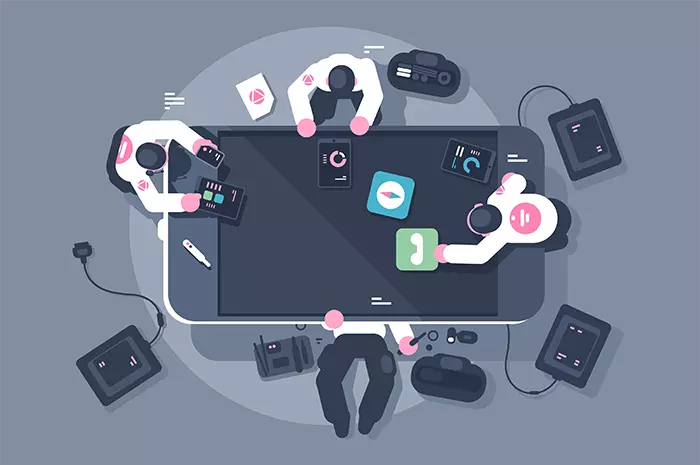Person Using Black And White Smartphone and Holding Blue Card
Sales via eCommerce have continued to rise, especially since the start of the Covid-19 pandemic. If you are planning to invest in an online shopping website, you first need to be familiar with the eCommerce customer journey so that you can stay ahead of your competitors.
Table of Contents:
Introduction: What is the eCommerce Customer Journey?
The eCommerce consumer journey refers to the stages of your customers' experience with your eCommerce business. It starts the moment that your customer learns about your product or service and continues even beyond the end of a purchase.
This customer journey for eCommerce is crucial, since it helps shape your customers' opinions of your business – and hence has effects your ROI. One of the reasons for viewing customer interactions as a journey with steps is that you can work on improving each stage.
Primarily, there are four steps to this journey:
-
Reach
-
Engage
-
Convert
-
Nurture
Stages of eCommerce User Journey
1. Reach
This stage involves getting people to click on your website through organic or paid traffic. It is potentially the most frustrating or challenging stage of the customer journey, since many businesses find they are not getting enough traffic.
To increase traffic, you can take several measures:
-
Promote yourself on social media channels: A social media strategy is crucial to growing your customer base. Use channels such as LinkedIn, Facebook, Twitter and Instagram to indirectly or directly promote your products and services. Publish good content regularly, especially images and videos. You can include paid ads for maximum reach.
-
Focus on SEO: Search engine optimization is a necessary step in increasing traffic. Use the right keywords and make sure your content is fresh, original and readable.
-
Use a mobile-friendly website: A mobile-responsive eCommerce website is necessary to stay ahead of competition, since many of your customers will be shopping from their phones or tablets and Google favors responsive sites. Websites that look great and function well on desktop may still be difficult to navigate on mobile devices. You can get a responsive website developed from professional web developers if you do not have the resources to do it yourself.
-
Your content should be engaging: All your content should be informative and valuable. Ideally, your customer should have a difficult time finding the same quality elsewhere. Such content can include product pages or articles. This will bring you to step two of the eCommerce customer journey.
2. Engage
Congratulations, you've got visitors on your website! Now you need to keep them there till they buy a product or service. Many visitors will "bounce" or leave your website quickly, or only look at one or two pages. Others will stick around but won't get to your products or services sections.
To engage your customers, you can:
-
Grab your visitors' attention: Use rotating carousel banners and make sure links are easy to identify.
-
Improve load speed: When was the last time you enjoyed waiting for a website to load when you wanted to browse products? Your visitors will bounce if your website doesn't load within 1 to 2 seconds.
-
Make it easy for customers to explore: Can your customers find the products they want within a few clicks? How easy is it for them to browse? You need to develop a navigation that allows them to view by category, new arrivals, manufacturers, and other filters.
-
Encourage users to make a purchase: Showcase product reviews, add relevant information that helps people decide what to buy, provide related products, and add a wish list. You can also allow customers to save their cart for later and make guest purchases.
3. Convert
This stage involves converting engagement into actionable items that grow your profits. Challenges at this stage include shopping cart abandonment, low value orders, or not even adding anything to the cart in the first place.
Here are some steps you can take to increase conversions:
-
Encourage larger orders: You can do this by informing customers of related or complementary products.
-
Simplify the checkout process: You need an efficient, secure payment gateway integration and easy checkout process. This will help reduce shopping cart abandonment and increase loyalty. You might want to include digital wallets or a single-page checkout, and reduce the amount of information your customer needs to enter.
-
Offer limited time deals. People love special promotions, sales and BOGO. You shouldn't make this your selling point, but you could profit from using deals judiciously.
-
Give your customer real-time shipping costs: Do not surprise your customer with shipping costs. Display your shipping rates clearly and accurately. Better yet, show the cost in the View Cart page, if your eCommerce platform supports it.
4. Nurture
You may be tempted to think that the eCommerce customer journey is over when a purchase is made. However, you still need to nurture your relationship, otherwise your customers won't return. This stage is all about long-term customer loyalty.
Nurturing largely involves communicating with users after they have made a purchase, with the goal of helping them remember your business. You will want them to like your brand and even advocate for you.
Here, you can:
-
Encourage customers to register: You can offer incentives such as a loyalty program to encourage guests to sign up. It's a good idea to give customers the option to register at the end of the checkout process, since they've already decided they're buying from you and might want to come back.
-
Communicate: Sent follow-up emails thanking customers for their purchase and requesting a product or delivery review. You can also send coupon codes, newsletters, and upcoming promotions and new products.
-
Improve customer satisfaction: Your customer should feel like an individual, not a number or a name on a roster. Provide swift and efficient customer service, periodically review your returns policy, and add chatbots or messaging apps.
-
Increase referrals: We may live in the digital age, but word of mouth advertising is still highly valuable, because people are more likely to trust recommendations from friends and family. Gift certificates, wish lists, and affiliate programs are great options for this.
Track Your Progress
To improve your customer journey and boost your ROI, you need to track your progress. Various software help you to do this, such as Google Analytics. Tracking will help you identify:
-
Bounce rate
-
Average orders per customer
-
Visitors
-
Top pages
-
Conversions
Creating an eCommerce Customer Journey Map
This is a visual representation of all the steps in the journey. Creating a map helps you to further understand your customers and make their experience seamless and enjoyable.
Here is how you do it:
1. Set goals
2. Identify customer personas
3. Chart out customer journey phases and identify touchpoints
4. Examine data to identify pain points
Conclusion
We hope this has given you an insight into the eCommerce user journey.
If you need professionals for your eCommerce website development, BluEnt is just a click away. We've been operating since 2003 and have served many businesses like yours.
Ready to boost your business with eCommerce site development? Contact us now!
Maximum Value. Achieved.



 How Much Does App Development Cost? A Budget Estimation Guide
How Much Does App Development Cost? A Budget Estimation Guide  Using Angular to Develop Mobile Apps Can Be a Game Changer for Your Business
Using Angular to Develop Mobile Apps Can Be a Game Changer for Your Business  Pros and Cons of the WooCommerce Plugin for Online Merchants
Pros and Cons of the WooCommerce Plugin for Online Merchants  Mean Stack vs LAMP Stack: Which One is Better for Your Business?
Mean Stack vs LAMP Stack: Which One is Better for Your Business? 